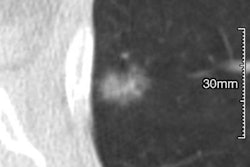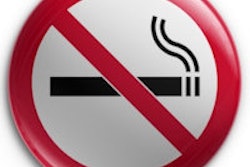
Medicare could save hundreds of millions of dollars by using the Lung-RADS system to work up suspicious lesions on CT lung screening exams rather than the protocol used in the National Lung Screening Trial (NLST), researchers reported on Tuesday at the American College of Radiology meeting (ACR 2016) in Washington, DC.
Joshua Roth, PhD, and colleagues calculated the potential difference in Medicare costs between the two systems over three years of annual low-dose CT lung cancer screening exams, based on the number of eligible participants likely to be screened, as well as the difference in false-positive exams.
In their model, the Lung-RADS-based approach was more than $250 million cheaper over three years, Roth said in an interview with AuntMinnie.com.
"I think this is a substantial amount, and it's based on implementing the most current evidence in terms of nodule management," he said. "This is where we stand today, and Lung-RADS has been an important advancement over what was done in the NLST."
An added benefit of Lung-RADS is that more people won't need to experience the trauma of waiting months to see if their positive finding is a false alarm, as they would under the NLST protocol. Lung-RADS produces fewer than half the false positives of the more loosely structured NLST technique, said Roth, who is from the Fred Hutchinson Cancer Research Center and the University of Washington in Seattle.
Comparing techniques
When the U.S. Centers for Medicare and Medicaid Services (CMS) granted final approval for reimbursement of lung cancer screening in February 2015, it stipulated that screening providers must use an approved nodule classification system to determine what constitutes a positive result or a suspicious finding. But CMS did not stipulate a nodule classification scheme.
In the NLST, all nodules 4 mm and larger were considered positive. But when the ACR created Lung-RADS in 2014, it specified that both nodule size and histology enter into the decision to classify a nodule as positive or negative, based on results from previous trials. For example, a 4-mm ground-glass nodule would not be considered positive under Lung-RADS, while a 4-mm part-solid nodule would.
How nodules are classified makes a big difference in terms of how many positive scans need follow up before the next annual screening round, changing downstream costs. So Roth and colleagues decided to calculate the costs of both the NLST and Lung-RADS approaches, using cost estimates largely extrapolated from a study published last year by Pinsky et al.
Roth and colleagues added to the Pinsky analysis an estimate of the number of people eligible for lung cancer screening based on another prior study. They also added an analysis of how many eligible people were likely to actually get screened, with the number of subjects rising slightly each year as more eligible patients became interested enough to sign up for CT screening.
"Among those who qualified for screening, we said, if they went through the Lung-RADS protocol versus the NLST protocol, how many would be truly positive and how many would be false positive?" Roth asked. "Then we used the diagnostic protocols from NLST and Lung-RADS to find out what those procedures would actually cost."
Procedures associated with following up the additional lung nodules considered suspicious under NLST versus Lung-RADS included additional low-dose CT scans, bronchoscopies, biopsies, and stage-specific treatments.
The model estimated the three-year incremental outcomes of screening using one or the other protocol for classifying nodules in an estimated Medicare population of 51.7 million members, of whom 5.8 million qualified for lung cancer screening. Outcomes were calculated based on perfect adherence to Medicare screening criteria and one of the nodule management protocols, the authors wrote in an abstract.
Assuming a gradual adoption curve for CT lung screening, the model estimated substantial spending reductions with Lung-RADS versus the NLST protocol over the three years:
- $242 million of savings in imaging expenditures
- $13 million of savings in invasive procedures such as bronchoscopy and biopsy
- $256 million reduction in total expenditures
Lung-RADS "substantially reduces the proportion with false-positive results, and that's important for a number of reasons" -- not least of which is that many patients don't have to worry for months while they wait to see if they have lung cancer or not, Roth said.
"I think one of the most important parts of the study is that it points out that the nodule management protocol really matters, both from a patient-centered perspective -- we don't want patients to worry about lung cancer if they don't have it -- and also from an economic standpoint," he said.
Still, he added, research is very active in this area, so screening providers can expect more big changes in recommended nodule management as new versions of Lung-RADS and other nodule management schemes come into play.




















